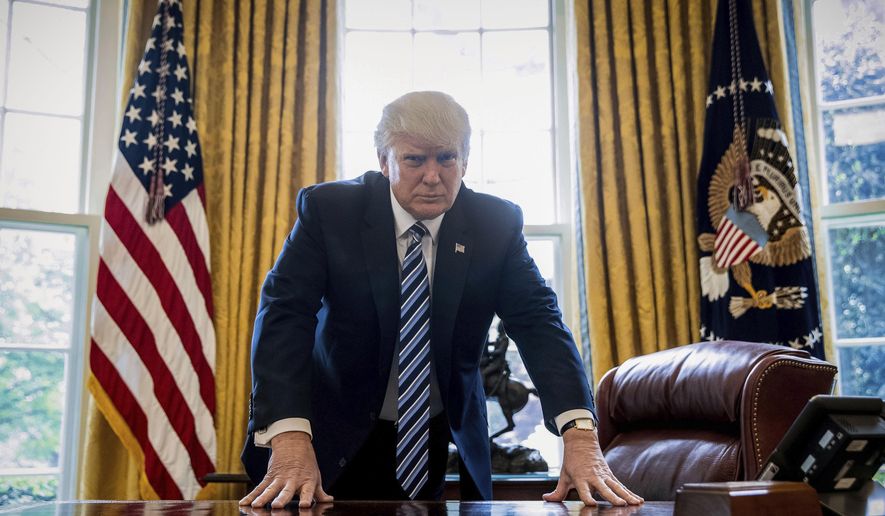President Trump’s hiring freeze helped cut the size of federal government by about 9,000 employees in his first six months in office, but that is just a drop in the bucket of a workforce of more than 2.8 million, and the administration has ended the freeze to fill mission-critical positions at agencies.
Mr. Trump ordered the hiring freeze on his first day in office and embarked on the most ambitious agenda to shrink government since Ronald Reagan. His early success, although modest, is a testament to the president’s tenacity and to the daunting task he has undertaken.
Reagan also imposed a hiring freeze on his first day in office, but the federal workforce grew by more than 100,000 employees by the time he left office eight years later.
In December, President Obama’s last full month in office, the federal government had more than 2.819 million employees. Mr. Trump cut the payroll to 2.810 million as of the end of July, according to the most recent employment report by the Bureau of Labor Statistics.
The numbers include active-duty military, which make up about half of the federal workforce. That makes the reductions more noteworthy because the Pentagon has embarked on a drive to hire 6,000 more recruits this year as part of Mr. Trump’s military buildup.
Still, hiring freezes have few fans in government reform circles.
“Hiring freezes are terrible ways to reduce the workforce — or to accomplish anything else that’s important. It’s a clumsy tool suited better for sending messages than for making policy changes,” said Donald F. Kettl, a public administration scholar at the University of Maryland.
“The real chance for big changes in the workforce will come with the budget,” he said. “That debate is being teed up. We will get a first look with the budget battles to come in the next two months.”
When the president’s budget director, Mick Mulvaney, announced the partial lifting of the freeze in early April, the federal workforce was headed toward a low point of 2.806 million full-time employees. The rolls swelled by about 5,000 workers by the end of May, according to the bureau’s data.
The original freeze never applied across the board. Mr. Trump excluded the military and positions deemed vital to public safety and national security.
In lifting the freeze, Mr. Mulvaney said, the administration opted for a “more surgical plan” to cut the workforce.
Since then, all agencies have complied with Mr. Trump’s April memorandum ordering them to submit workforce reduction plans. The plans are being reviewed and integrated into the president’s 2019 budget, White House officials said.
“We continue to move forward with governmentwide reform efforts, and agencies are actively working to right-size and align human capital resources to achieve proper and appropriate agency functions in the most efficient and effective manner,” the official said.
The 2018 budget gave a glimpse of the direction the Trump administration is heading. It called for eliminating 24,000 full-time employees across 17 agencies.
One of the largest cuts was to the Environmental Protection Agency, which would have shed 3,800 jobs, or 24 percent of his workforce. Another was the Interior Department with 4,100 jobs cut, or 6.3 percent of its employees.
Other departments — including the Pentagon, Homeland Security and Veterans Affairs — would have workforce boosts.
“The budget they came out with made a lot of sense and would have been a positive step. It’s a shame the House and Senate haven’t given it attention,” said Rick Manning, president of the nonpartisan Americans for Limited Government.
Chris Edwards, director of tax policy at the libertarian Cato Institute and author of “Downsizing the Federal Government,” said Mr. Trump will need cooperation from Congress to significantly shrink the federal workforce.
Cooperation from Congress, however, has been a scarce commodity for the Trump White House.
“To push Congress, reform-minded Cabinet secretaries and the [White House Office of Management and Budget] should be putting efforts into studies and data releases that highlight the failures of federal programs and excesses in the bureaucracy,” he said. “One concern, however, is that so many high-level agency positions have not been filled with political appointees yet in order to drive reforms.”
He noted that a recent agriculture policy debate was driven by a 2006 Commerce Department study that outlined how sugar regulations were damaging the U.S. economy.
“It was influential, and I’ve seen it cited many times,” said Mr. Edwards. “So while it waits for congressional actions on reforms, Trump appointees in federal agencies should be pushing for more studies, data and transparency that support the case for reforms of federal programs and policies.”
A study by the Bipartisan Policy Center confirmed the Trump administration’s slow pace at filling critical federal agency management jobs.
The 50 Senate-confirmable positions identified by the center were outside the hiring freeze.
While Senate Democrats have succeeded in slow-walking Mr. Trump’s nominees to confirmation, the president also has lagged behind his predecessors in the pace of nominations. At the same point in their first terms — the 200-day mark — Presidents George W. Bush and Barack Obama had nominated people for more than 75 percent of the critical positions, compared with 57 percent so far for Mr. Trump, the study found.
“You have to have your political appointees in place to make sure the agencies do what you say,” said Mr. Manning of Americans for Limited Government. “It is still like turning a battleship. But without your political appointees in place, there is no one turning the rudder.”
• S.A. Miller can be reached at smiller@washingtontimes.com.




Please read our comment policy before commenting.